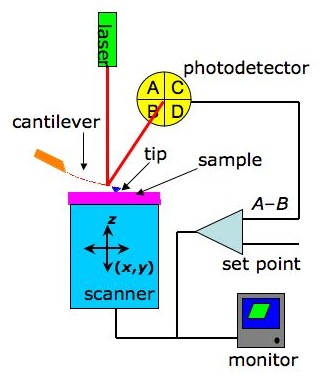- contact-mode AFM
- tapping mode AFM
- force-modulation mode AFM
- force spectroscopy
- force-volume AFM
- magnetic force microscopy (MFM)
- lateral force microscopy (LFM)
- scanning tunneling microscopy (STM)
- fluid operation
- temperature control

One of the primary experimental instruments employed in my research is the atomic force microscope (AFM), which uses a sharp probe attached to a weak cantilever spring to measure structures and forces at the nanometer and pico-Newton levels. Still only 20 years old, development of new AFM techniques continues. The AFM in my lab (a Digital Instruments MultMode with NanoScope IIIa controller) is capable of
|
 |
|
| Through contacts elsewhere on campus, we also have access to techniques such as interfacial force microscopy (IFM), conductive AFM (C-AFM). |
Because we use the AFM for quantitative force measurements, we require accurate calibrations of the cantilever spring constant. We have a separate web area to describe our calibration methods in detail, and provide calibration services for the local AFM community.

AFM contact-mode height image of a wax "island" one monolayer thick on a silicon surface. The apparent trench (dark ring) is a friction artifact: it is actually a low-friction phase, perhaps liquid wax, above the substrate but below the top of the island (central spot). The scale bar indicates 2 µm. |
Recently, we have been exploring the effects of friction on ordinary AFM contact-mode imaging. Image artifacts due to friction have long been recognized, but have not been examined in detail due to perceived technical difficulties. However, we find that we can reliably predict the effect of friction on height imaging, thus permitting friction information to be extracted from trace/retrace height images. Although this method is unlikely to replace the usual methods of lateral force microscopy, it is useful for calibrating the torsional spring constant, which normally requires specialized substrates. |
Last updated July 16, 2005